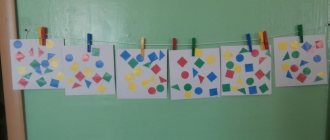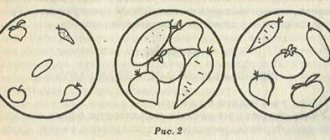Senior group. Senior preschool age. Children 5-6 years old
Photo report “Lego Boom” with older children
January 28th is International LEGO . All children are familiar with this wonderful construction set , which consists of plastic bricks. LEGO does not limit a child’s imagination, but on the contrary, captivates him. Children enjoy the process of assembling parts, and the result is not only pleasing…
Scenario of a quest game for children of senior preschool age using Lego technologies “In Search of Treasures” Scenario of a quest game for children of senior preschool age using Lego technologies “In Search of Treasures”
.
Equipment: attributes of pirates, a map, containers with Lego sets , cut-out pictures of ships, cotton pads, two “Number - Color”
, a pirate flag...
Summary of a lesson on Lego construction for children 5-7 years old “The Evolution of Construction”
SUMMARY of organizing joint continuous educational activities with preschool children
Topic: Evolution of construction Age group:
children 5-7 years old
GCD form
: Lego construction technology
Subgroup
form of organization Educational and methodological set
: set of tasks “Construction machines” for the LEGO® designer set 45002, TRIZ technology
Means:
visual LEGO® set 45002 “Construction machines”, “Giant duplo set”, bricks from the LEGO SOFT set, axonometric projections of machine models, tables – system operator, pencils;
On the stand is a finished building with a construction site on which workers are located with a shovel, cart, concrete mixer, scraper, stepladder; multimedia presentation “Evolution of construction”, educational cartoon “Working machines for children”. OBJECTIVES of the educational program: Educational objectives:
• to develop the cognitive initiative of preschoolers in the process of generalizing ideas about construction machines through design;
• form ideas about the structure and history of machines; • develop logical thinking, promote the development of systems thinking; search for a problem and suggest ways to solve it; • develop cognitive interest and design skills based on images using a simple screwdriver; demonstrate the functions of the model and their management; Educational objectives:
• to develop cooperation skills in the process of joint activities;
• encourage the desire to independently search for knowledge and skills, develop the ability to invent games; • awaken curiosity, the ability to make decisions in accordance with the task, develop creative imagination, help acquire the skill of coordinated teamwork. In the technical dictionary
• Equilibrium • weight • experiment • distance Parts: chassis, wheels with tires, bucket, scraper, lever, boom Equilibrium An object is in equilibrium and does not move when all the forces acting on it are equal in magnitude and opposite in direction.
Fulcrum The point, or center, about which a lever, such as a lever, pivots or rotates. Vocabulary work: evolution, efficiency, equipment, design, architect, drawing, foundation pit, foundation, system operator, grader, milling cutter, asphalt paver. Expected result: 1. Ability to work in a team, carry out simple construction according to a model.
Developed ability to reason and debate. 2. Demonstration of curiosity, the ability to make decisions in accordance with the task, developed creative imagination. 3. Familiar with concepts such as bolted structures. The skill of designing from a drawing and axonometric projection is developed. 4. The ability to put forward your own hypotheses, assumptions, and describe the results. Children's creative activity and the experience they gain give them ideas for continuing research. Contents of the activity:
Stage 1 Establishing relationships (Goal setting) 1. Tower of Friendship. - In order for us to become more friendly, we need to assemble a tower. Look at the drawing, one-two-three - quickly start. Following the model in the presentation, children build a tower using Lego-soft blocks according to colors in teams of boys and girls - who is faster. Then they check for correctness. To quickly check the color sequence of a tower, you can turn one of the towers upside down. The towers will be the same.
2. Conversation: - What profession were you representatives of when you built your towers? — What other construction professions do you know? - What can’t you build a house without? (drawing, pit, foundation, equipment, building materials, construction site, specialists, equipment, etc.) - Were you now builders in our time or in ancient times? Express your assumptions and justify them. On the screen is an illustration of a construction site in ancient times.
3. Working with the system operator. (work cards)
— what item or tool is needed for each stage of construction? What if we are still in the past tense? Sketch it out schematically. 4. Using a presentation, we check the filling of each cell of the system operator (stage 1, start of construction - architect and drawing, stage 2, digging a pit - shovel and scraper, 3 - cart for transporting building materials, 4 - people to lay the foundation, 5 - concrete mixer , to pour the foundation, 6 – a stepladder to lay the bricks up.)
5. Determination of the problem when using such tools (long time, a lot of physical and human costs, ineffective). A suggestion on how to deal with the problem. A proposal to design equipment that will replace the unskilled labor of builders. 6. Moving in OUR TIME. (Dynamic pause). Teams are invited to build bridges from the past to the future from Lego soft, which would be durable, but raised above the floor. 7. A picture of construction in our time at the presentation.
Stage 2 Design (Creation of a model) 8. Creation of construction equipment from the construction set 45002 “Construction machines” in pairs. According to step-by-step drawings or according to a drawing in an axonometric projection.
Definition of the principle of working in pairs: one selects parts - the other builds; everyone assembles their own design, then they combine them; everyone assembles 2-3 stages in turn, etc.) - Without what will the machine not work? (engine, fuel, driver, wheels). Stage 3 Reflection (Discussion) 9. At the stand with a house and a construction site, you need to replace the outdated construction model with equipment that corresponds to the task being performed. 10. Filling out the second column of the system operator. (what equipment is needed at each stage of construction). Check your assumptions using ready-made answers in the presentation table.
Stage 4 Development (Transformation) Open end 11. Presentation: comparison of past and present construction methods. - What's better? – What is more effective? — What problems can arise in modern construction? 12. Self-esteem: - What surprised you? - What can you praise yourself for? - Why do you need this knowledge? — What else would you like to build, learn about mechanisms and devices for construction? 13. – What will the construction of the future look like? Dream at home and bring your drawings.
— Do you know what a milling cutter and asphalt distributor are? Where can I find out about this? I suggest you watch a film that tells about rare, but very necessary construction machines.
We recommend watching:
Lego construction for the development of speech in preschoolers A creative project for Lego construction in kindergarten. Senior group Regulations on holding a competition-exhibition on Lego construction and robotics for preschoolers Didactic game for developing computing skills in preschoolers
Similar articles:
Development of communication skills in design and research activities in preschoolers
Lego. LEGO constructor - Lesson notes for children of the senior group “City for Lego Men”
Publication “Lesson summary for children of the senior group “City for...” “City for Lego men” (senior group) Educational areas: artistic and aesthetic development. Integration of activities: cognitive - research, gaming, communicative. Lexical topic: “A city for Lego men” Type of lesson: collective -…
Abstract of the OOD "Travel with Dunno" using a Lego constructor in the senior group. Abstract of an OOD using a Lego constructor in the senior group. Topic “Transport” “Travel with Dunno” Objectives: Develop interest in creating variable designs from Lego material. Update your understanding of different types of transport, the ability to systematize objects...
Additional education program for children of senior preschool age in Lego construction “Cogs and Pins” Explanatory note We live in an era of modernization and computerization of society, in which modern children, already at preschool age, give preference not to soft and didactic toys, but to all kinds of gadgets, robots and transformers . However, over the years...
Development of coherent speech in children of senior preschool age using Lego technology Municipal budgetary preschool educational institution "Kindergarten No. 50" PRESENTATION On the topic: "Development of coherent speech in children of senior preschool age using Lego technology" Prepared by: Educator Lyukmanova Svetlana Aleksandrovna 2022 Dzerzhinsk...
GCD for Lego construction “Building a house” lesson plan (middle group)
Scenario of educational activities
(middle group)
Topic: “Building a house”
Integration of activities (cognitive - research activities, communicative, constructive).
Goal: Development of children’s cognitive activity in the process of organizing constructive-model activities
Tasks:
Educational (aimed at developing the child’s competencies):
- to form in preschoolers an idea about building a house;
- vocabulary replenishment
Developmental (aimed at developing mental processes, including speech):
- Develop interest in constructive modeling activities.
- Continue to introduce Lego and model with it.
- Develop fine motor skills of the hands.
Educational (aimed at developing personal qualities and interpersonal relationships):
- Foster activity, initiative, and independence.
- Develop the ability to finish what you start.
Tools, equipment, materials:
visual (demonstration material): presentation, diagrams, Lego men, technological map for assembling a house
handouts: Lego constructor
Technological map of educational activities
| № | Stage of educational activities | Progress of educational activities | ||
| Activities of a teacher | Children's activities | Ways to support children's initiative | ||
| 1. | INTRODUCTORY PART | |||
| Organizing time | (Music sounds) children enter the group and see a sick box -Hello guys, Do you know what or who is in this box? Today Lego men came to us and asked us for help. - Shall we help them? | (Children enter the group). -Hello! No Yes | Musical accompaniment; lego men; | |
| Problem situation (or motivation) and setting and acceptance by children of the goals of educational activities | -Lego men can't cope with building a house. They don't have any time left. Only one drawings - Who knows what a drawing is? — A drawing is a schematic drawing of knowledge or some kind of building. | Children's answers | The teacher shows the children sheets with the diagram | |
| 2. | MAIN PART | |||
| Designing solutions to a problem situation, updating knowledge, or starting to take action on the objectives of educational activities | -Let's look at the images. - Tell me, what is there at the house? — Pay attention to the screen. | Look at the images Walls, roof, windows, floors, stairs, doors Children see on the screen pictures of houses | House floor assembly illustrations; Working with a presentation Game for attention | |
| “Discovery” of new knowledge and ways of action by children | — What else must be done so that a person can get into his cozy home? Where will we use the biggest LEGO pieces? — What parts does the house itself consist of? Finger gymnastics to increase strength in the hands I will build a house. (Raise your hands above your head like a house) And there will be a window in it. (Join the thumbs and index fingers of both hands to form a rectangle) To make a beautiful entrance to it. (Turn your palms towards you and close them with the side ribs, straightening all your fingers) There will be a fence around (Place your hands in front of you in a ring, connecting your fingers) | entrance We use the largest construction parts for the base of the house. from medium and small construction kit parts | Finger gymnastics to music; conversation with children | |
| 2. | Independent application of new things in practice, or updating existing knowledge, ideas, (performing work) | Divide into pairs and sit at the tables. Each person has a set of parts and an assembly diagram on their desk. Assembling according to the diagram | Sit down at the tables Independent work according to the scheme | Parts kits |
| 3 | FINAL PART | |||
| The result of educational activities. Systematization of knowledge. | Now I suggest you now connect all the floors. - let's count how many floors we have - how many floors? | Connect I think 7 floors | ||
| Reflection | You have 3 emoticons on your tables, fill in the one that matches your mood and whether you liked the activity | Execute | Joyful mood; | |




